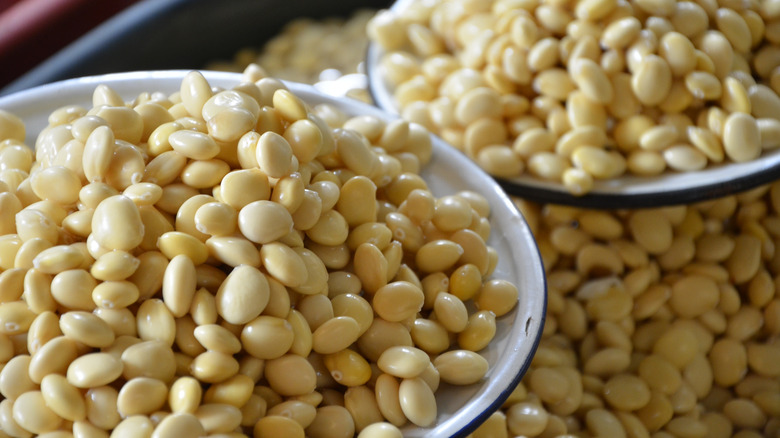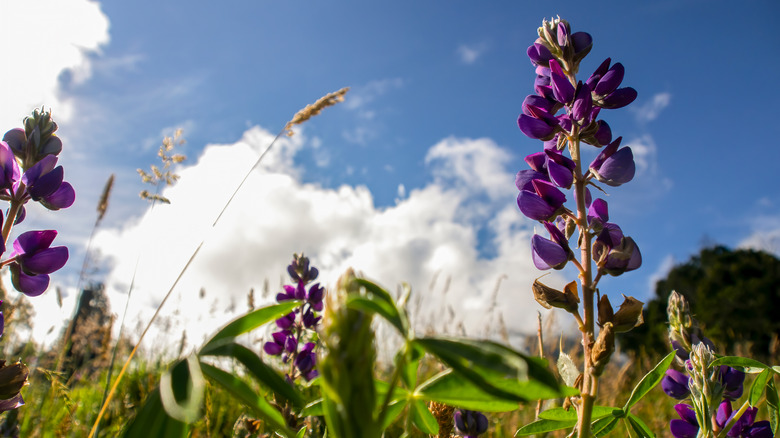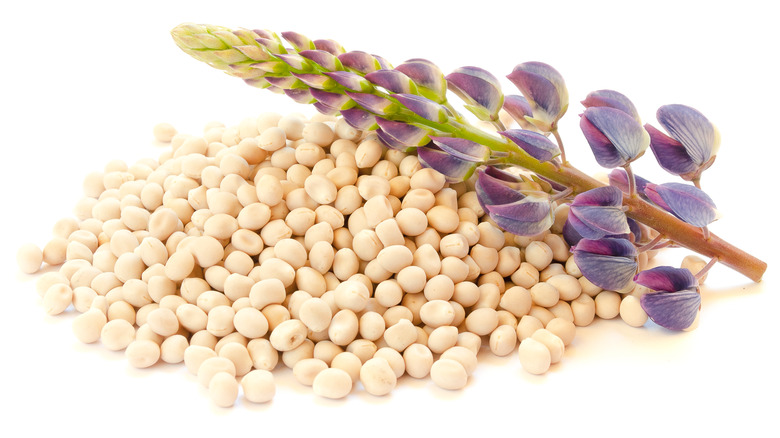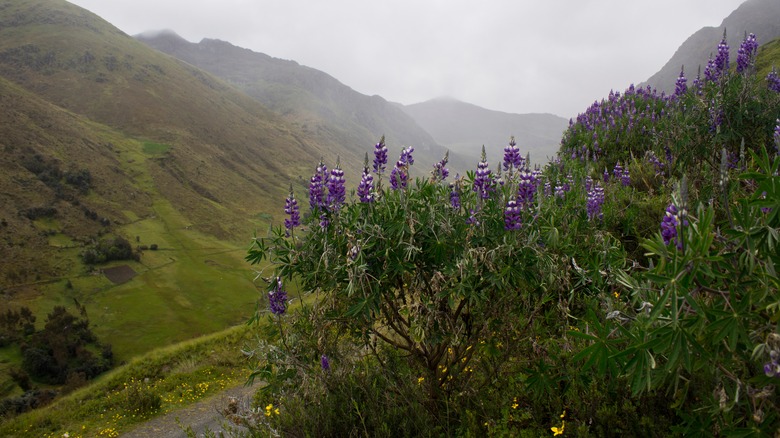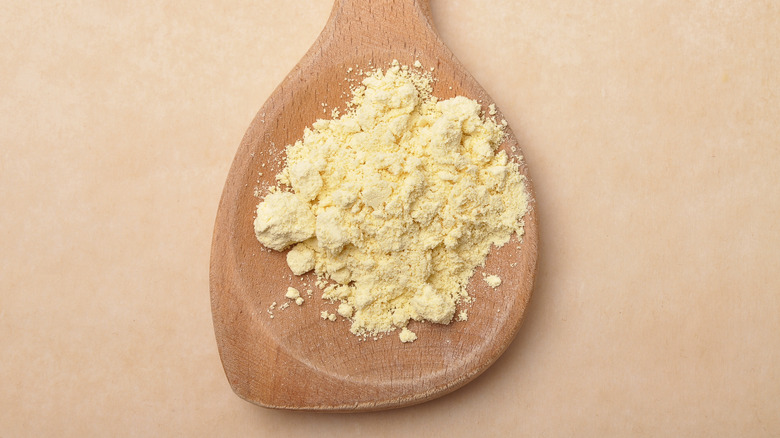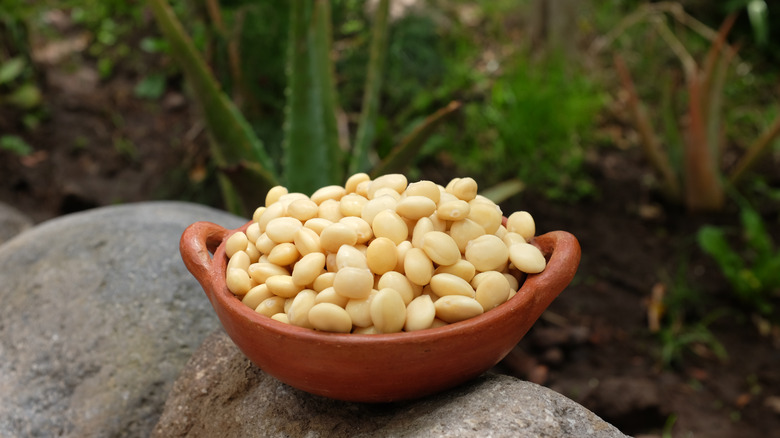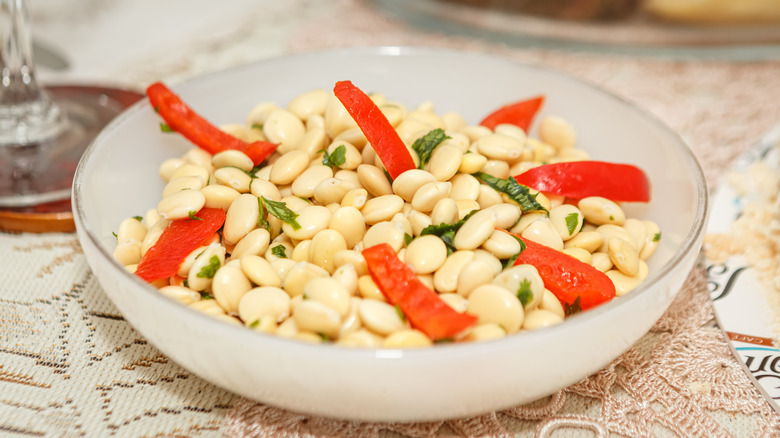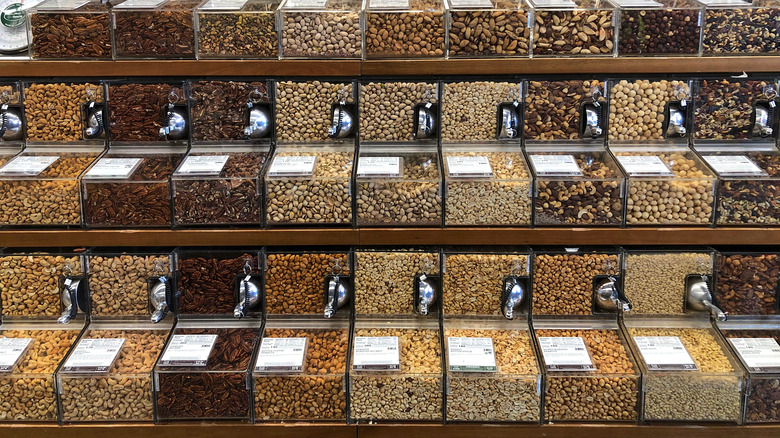What Is Chocho And How Do You Use It?
Called "tarwi" in Quechua, and "lupini" in English, the Spanish legume "chocho" is a relatively new name on the list of superfoods. Scientifically known as Lupinus mutabilus, chocho is a type of lupin bean that has been cultivated in the high altitudes of the Andean Mountains in South America for over 1,500 years (via Slow Food Foundation). Besides containing more protein per serving than any other bean — yes, even soybeans — chocho is a naturally regenerative crop. This means that chocho's benefits go beyond your own to the betterment of the planet (via Mikuna Foods).
In a world with increased awareness around the modern food supply system and its role in environmental decline, plant-based, regenerative foods like chocho are gaining momentum. The term "regenerative" takes many meanings. Biologically, it refers to the regrowth of damaged or destroyed cells, and spiritually, it signifies renewal and rebirth. But agriculturally, regenerative refers to the philosophy of farming in a way that restores the health of both the soil and ecosystem (via NRDC). In this way, chocho does a lot of good for you and the environment. So why not learn how you can start using it?
What is chocho?
Chocho is a particular type of lupin (Lupinus genus) and a member of the legume family. Despite being cultivated since pre-Incan times, the genetic biodiversity of Andean lupin beans has remained practically the same. The most commonly harvested types of lupins include blue lupins, white lupins, yellow lupins, and chocho (via Mikuna Foods). Sometimes found in granola bars and snack mixes, blue lupins (also referred to as sweet lupins) have hit a particular stride in products across Europe and Australia, where they are often used in plant-alternative foods (via Five Suns Foods). However, none of the lupin varieties contain as much protein content, or as many essential amino acids, as their Andean cousins do.
The chocho plant can reach heights of up to two meters tall while sprouting large, hairy sprouts of bean pods and brightly colored purple flowers (via Kahlos Eyes). They are indigenous to places like the Peruvian Andes, the Volcano Valley of Ecuador, and the highlands of Bolivia. But unlike sweet lupins, chocho is not hybridized. This means it contains alkaloids, a compound that is naturally produced by the plant to keep bugs and other potential predators away. These alkaloids make the unprocessed plant particularly bitter, so chocho requires quite a bit of time and effort in order to be edible. Paired with the stigmatization of the crop, this labor-intensive processing led to its decline as a common staple (via Mikuna Foods). But for chocho, there's no better time for a comeback than now.
How is chocho made?
Chocho plants thrive in cool temperatures, which is why they are typically found growing in valleys with high altitudes. The plants reach their peak in the winter, but because they're grown in the Southern Hemisphere, the chocho is harvested in late September— around the end of the Southern Hemisphere Winter/early summer (via Mikuna Foods). Their scientific name, Lupinus mutabilus, is suggestive of the plant's ability to mutate and adapt to its environment. While they're easily grown on farms from California to Russia, and England to Australia (via Modern Farmer), they grow best in areas where they can stay cool without freezing, AKA high altitudes where they're closer to the sun.
When it comes to farming, chocho is fairly easy-going. Because they thrive in drought conditions, chocho are solely watered by rainfall. Additionally, these plants produce their own alkaloids, which eliminates the need for pesticides that not only deplete the soil of nutrients, but are connected to chemical runoff. However, what makes this tiny legume a true "superfood" is its natural superpower: nitrogen fixation.
Chocho and soil regeneration
Recognized as "one of the most efficient legumes for stabilizing atmospheric nitrogen" by the Sustainable Development Goals Fund, chocho can take nitrogen from the atmosphere, convert it into ammonia, and release it into the soil for them, and all other plants, to enjoy (via Frontiers in Plant Science). For this reason, chocho has great potential as a rotation crop, where it can be used in place of fertilizers or pesticides to add biodiversity to the land and improve the quality of the soil, all while increasing production for farmers (via Mikuna Foods).
At the end of the Southern Hemisphere winter, the chocho are harvested. Then, they're dried whole and the chocho beans are removed from the pods to be stored until it's time for processing. In the past, it took days of soaking to remove the alkaloids, but, today there are new technologies that have been developed to speed up the soaking process, or remove the bean's outer layer altogether (via Food Dive). Either way, once the alkaloids are removed and the beans are considered safe to eat one of a few things could happen: they could be ground into powder, sealed into jars or cans, pressed into oil, or dried and sold whole.
Chocho beans vs. chocho powder
Chocho beans have been cultivated and consumed in the Andes and South America for thousands of years, but recently a market has also opened for another form of the Andean lupin: chocho powder. When eaten whole, chocho beans retain their shells, which means they contain more calcium and fiber than powder. The drawback, of course, is the processing time. In order to remove the alkaloids, chocho beans have to be soaked for days, sometimes longer than a week (via Kahlos Eyes). While machinery has been developed that aids in this process, if the alkaloids aren't properly removed, the beans will taste extremely bitter — and could potentially make you sick.
Chocho powder, on the other hand, is typically made without the shells entirely. Even though this cuts out most of the bean's calcium and fiber content, it helps to neutralize the flavor and makes the beans easier to digest (via Food Dive). While the powder form of chocho beans is convenient in its own ways — including processing time, digestion, and use — it also has its own cons. The powder can easily be thrown into a smoothie, protein shake, or used as a replacement for gluten-free flour. However, you'll miss out on the consistency of the bean itself, which has shown its versatility in a range of traditional Andean and South American dishes for millennia.
What does chocho taste like?
As discussed, the flavor of chocho depends greatly on the processing method. If alkaloids are left on the beans, they'll taste bitter to the point that they're virtually inedible — and they are. Consuming excess amounts of alkaloids can have side effects like nausea, weakness, and blurred vision (via Living in Peru). However, once they're soaked away, or the shells have been removed entirely, the bean itself has a wonderful nutty flavor.
One chocho fan told Five Suns Foods that "if edamame and chickpea had a baby, it would be chocho." That sounds pretty on par, considering chickpeas are known for their nuttiness, and chocho's texture is frequently compared to that of soybeans (via Living in Peru). However, as a powder, chocho's flavor profile is fairly neutral and is hardly evident when used as a substitute for protein powder or flour. This is great news for those of you who are sick of the bitter, chalky taste common in vegan protein powder substitutes.
How to cook with chocho
When cooking with chocho, you can think of them like any other type of bean. Their nutty flavor makes them particularly delicious in cold salads, and they've been used in Ecuador and Peru as the protein in a vegan ceviche (via Five Suns Foods). But it's important to note that if your recipe relies on the bean's texture, you should go with the dried form of chocho beans instead of the canned. This will also require some pre-planning on your part, because dried chocho beans can take as long as seven days of soaking before they're ready to actually eat (via Kahlos Eyes). Unfortunately, there's no way around it — if the alkaloids aren't removed, no amount of seasoning will cover their bitter taste. But if you're using chocho in a soup or porridge, you can save yourself time and effort by buying the canned chocho instead.
Chocho powder is much more straightforward. As a powder, chocho can take the place of protein powder in your shakes and smoothies. The flavor is very neutral because the shells of the chocho were removed in the process. This means that no matter what flavor shake or smoothie you're used to, chocho powder won't affect the taste. Because of its mild flavor, it also works wonderfully as a high-protein, gluten-free flour alternative (via Living in Peru). From bread to pizza crust, and cookies to pasta, chocho powder can take the place of white flour in any recipe.
Where to buy chocho
Outside of the Andes and South America, chocho are still relatively new. For this reason, they're a rare find in supermarkets in the United States. You're most likely to find chocho beans at your local Latin or Italian market, where they're typically sold pre-soaked and packaged in a jar, or vacuum-sealed. You can also check the dry food aisle for the dried beans. Just remember to look for labels that say "chocho," or "tarwi" in the Latin market, and "lupini" in the Italian market (via Living in Peru). Your other option is to order the beans online, straight from Ecuador as Kahlos Eyes did.
When shopping for chocho powder, your best bet is to get it online. Brands like Mikuna Foods sell it by the bag, and it even comes in flavors like chocolate and vanilla. If you're baking with chocho powder, you should go with the plain flavor. Keep in mind that you can still use it in smoothies or shakes and just add in sweetener on your own. But odds are good you won't need to add anything at all.
Chocho nutrition benefits
Chocho contains more protein than any other plant source, comprising 54% of its weight to deliver 26 grams per serving (via Living in Peru) compared to tofu's 14 grams per serving (per Tofu Bud). According to Five Suns Foods, it comes complete with all nine essential amino acids. Chocho is also easily digestible, thanks to its prebiotic abilities (via Mikuna Foods) and allergen-friendly. These characteristics of chocho make it a superb plant-based protein source, particularly for those of you who are 100% vegan and could use the lysine, or for anyone looking for vegan options beyond plant-based milk.
No matter if you're consuming chocho powder, or the beans themselves, you'll get the same amount of protein per serving. However, when you eat chocho beans whole, you get the benefits that come with the shell — a rich source of fiber and calcium. A chocho bean contains 300 milligrams of calcium, as much as a glass of milk (via Food Dive). Additionally, thanks to its net-zero delivery of insoluble fibers, which are also most prominent in its shell, chocho has a low glycemic index. In fact, a 2012 study published in the journal Nutricion Hospitalaria found chocho to be helpful in treating chronic hyperglycemic diseases. And remember — not only is chocho a complete plant-based protein, but it's naturally regenerative. So you aren't just fueling your body when you eat it, but a better, more sustainable future.
